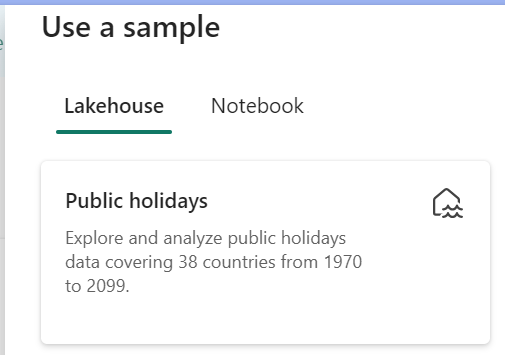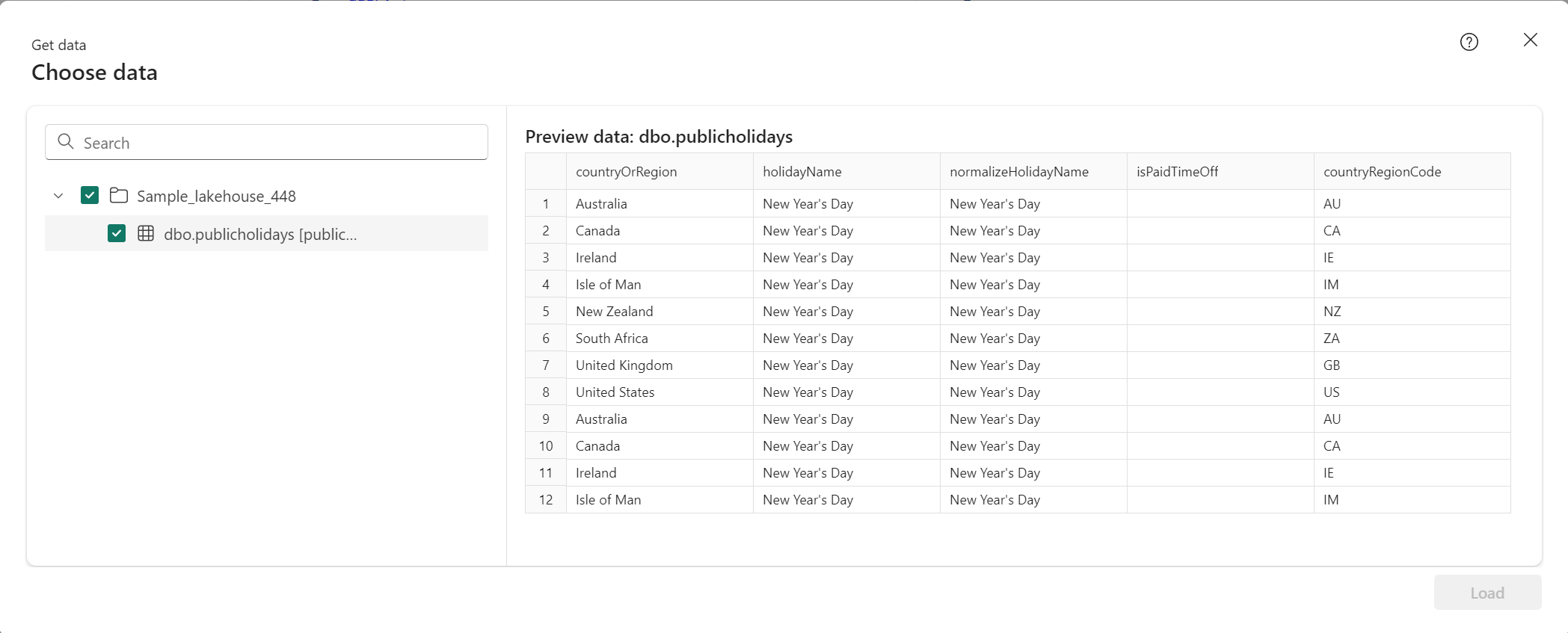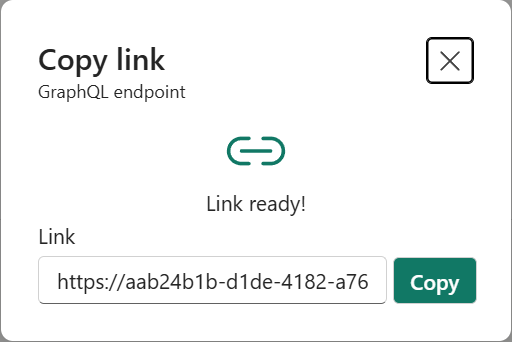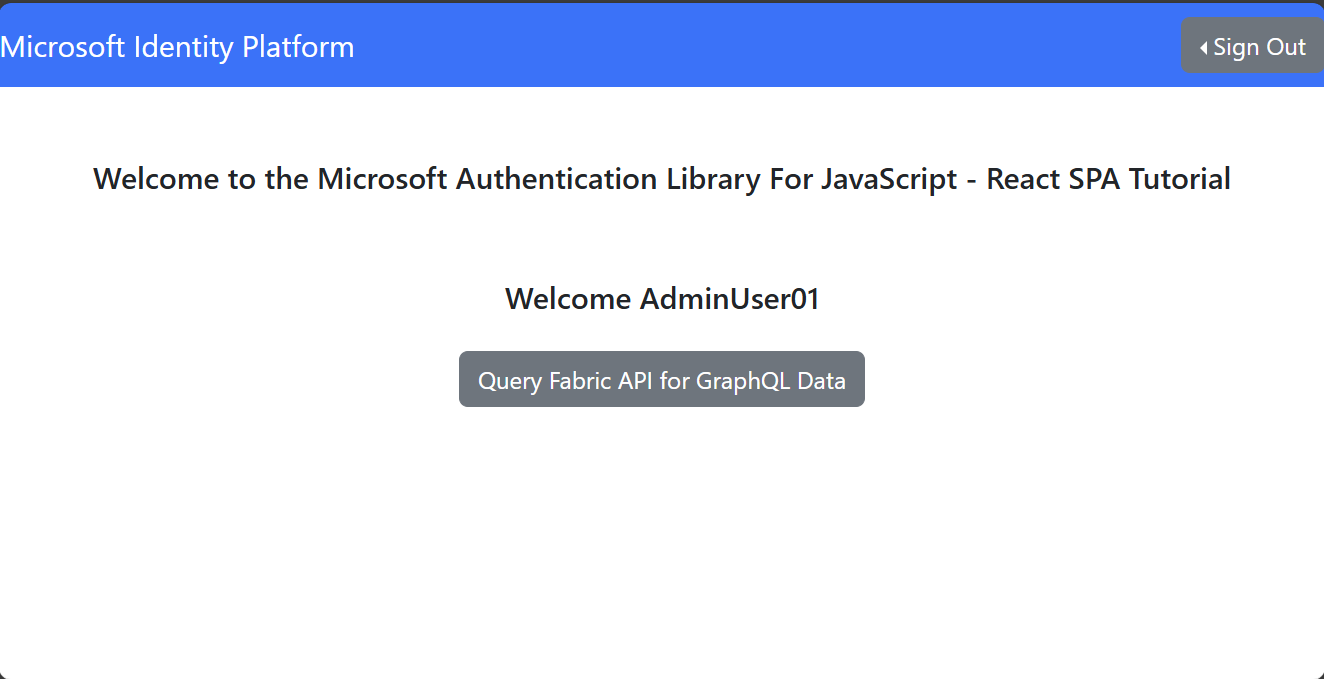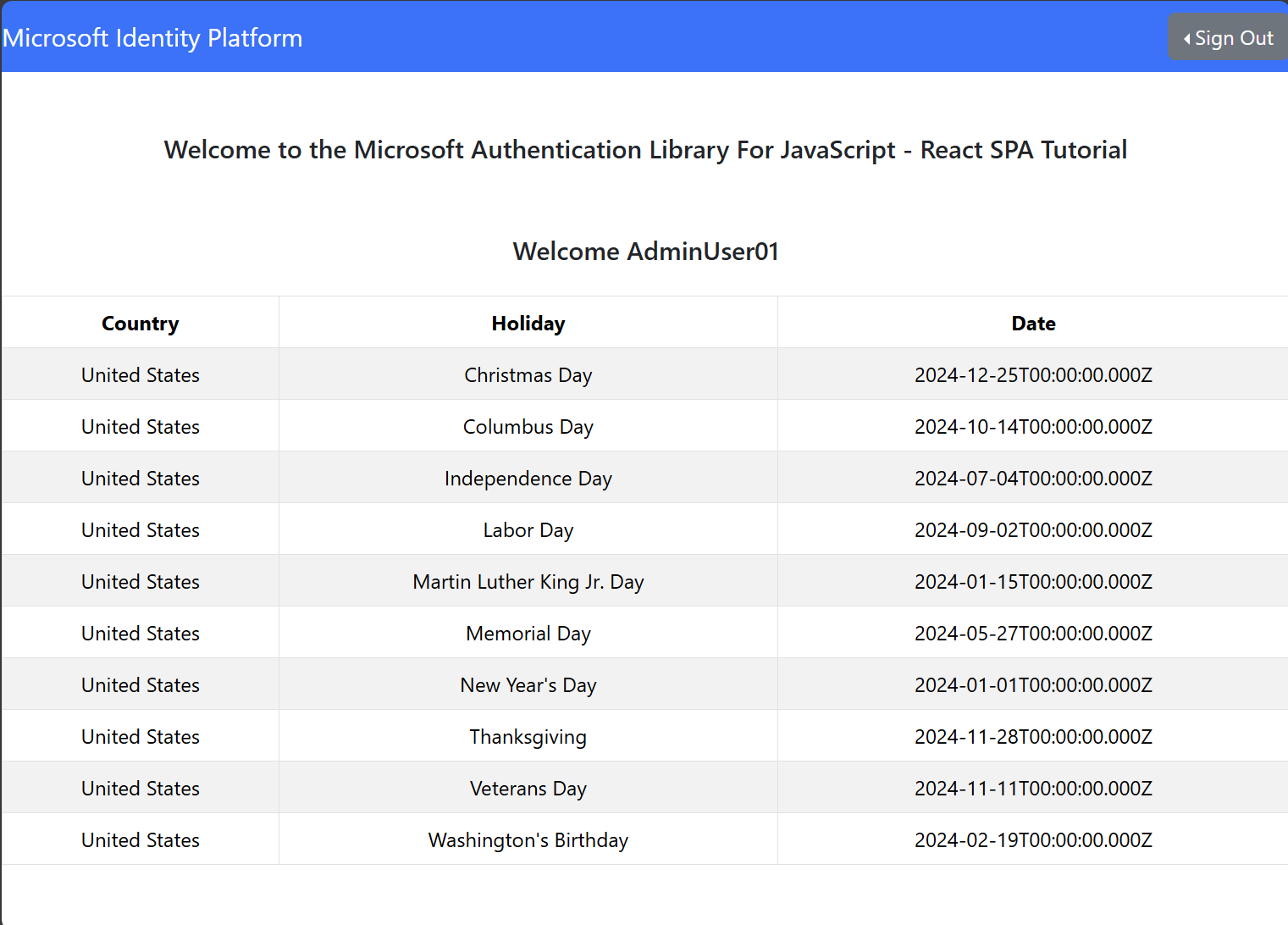Note
Access to this page requires authorization. You can try signing in or changing directories.
Access to this page requires authorization. You can try changing directories.
To connect an application to an API for GraphQL, you need three key details: a Client ID, your Tenant ID, and your GraphQL endpoint address in Fabric. The following sections explain how to create and retrieve the required details and access your API using a sample React application.
Other languages
This tutorial explains how to connect a React sample application to Fabric API for GraphQL. You find C#, Python, and other language samples in the Microsoft Fabric Samples GitHub repository.
Prerequisites
Before connecting an application, ensure you have an API for GraphQL in Fabric. For more information, see Create an API for GraphQL in Fabric and add data.
The API for GraphQL requires applications to use Microsoft Entra for authentication. Register and configure your application to perform API calls against Fabric. For more information, see Create a Microsoft Entra app in Azure.
The authenticated credential (user principal, service principal, or managed identity) calling the API needs Execute permissions for the GraphQL API (Run Queries and Mutations option when adding direct access permissions). If using single sign-on (SSO) as the connectivity option in the API, ensure the credential has read or write permissions in the chosen data source. For more information, see Connect to a data source and build your schema.
Create a Microsoft Entra app
The following steps explain how to configure support for a ReactJS application in Microsoft Entra.
Register an application using the steps described on Quickstart: Register an application with the Microsoft identity platform.
The Microsoft Entra app Application (client) ID and Directory (tenant) ID values appear in the Summary box. Record these values because they're required later.
Under the Manage list, select API permissions, then Add permission.
Add the PowerBI Service, select Delegated permissions, and select GraphQLApi.Execute.All permissions. Confirm that admin consent isn't required.
Go back to the Manage list, select Authentication > Add a platform > Single-page application.
For local development purposes, add
http://localhost:3000under Redirect URIs and confirm that the application is enabled for the authorization code flow with Proof Key for Code Exchange (PKCE). Select the Configure button to save your changes. If the application encounters an error related to cross-origin requests, add the Mobile and desktop applications platform in the previous step with the same redirect URI.Back to Authentication, scroll down to Advanced Settings and, under Allow public client flows, select Yes for Enable the following mobile and desktop flows.
Set up a sample GraphQL API for application access
In this example, we create a GraphQL API to expose sample Lakehouse data to clients.
From the Fabric portal home page, select Data Engineering from the list of workloads.
In the Data Engineering experience, select Use a sample, and under Lakehouse, select Public holidays to automatically create a new Lakehouse with public holidays data.
Follow the steps from Create an API for GraphQL to create a new GraphQL API and select the Lakehouse you created. Add the public holidays table so clients can access this data.
Test the GraphQL API in the API editor using the following sample query. It's the same query used in the React client application:
query { publicholidays (filter: {countryRegionCode: {eq:"US"}, date: {gte: "2024-01-01T00:00:00.000Z", lte: "2024-12-31T00:00:00.000Z"}}) { items { countryOrRegion holidayName date } } }Select Copy endpoint on the API item's toolbar.
In the Copy link screen, select Copy.
Use the Client ID and Tenant ID from the Microsoft Entra app recorded earlier, and copy the endpoint URI because it's required later.
Configure a React app to access the public holidays API
Note
If you prefer to skip the following manual steps, you can clone the GitHub repository with the complete application. Follow step 3 to add specific details about your GraphQL endpoint and IDs retrieved from Microsoft Entra to the file authConfig.js, install dependencies with npm install and skip to step 9 to proceed with testing the application execution.
Use an existing React app as a starting point. Follow the steps in the tutorial Create a React single-page application and prepare it for authentication to create a React project with Microsoft Entra authentication configured, including the required files and folders added to the project structure. Change three files to adapt the app for the GraphQL use case.
In the
srcfolder, open theauthConfig.jsfile and replace the contents of the file with the following code snippet:/* * Copyright (c) Microsoft Corporation. All rights reserved. * Licensed under the MIT License. */ import { LogLevel } from "@azure/msal-browser"; /** * Configuration object to be passed to MSAL instance on creation. * For a full list of MSAL.js configuration parameters, visit: * https://github.com/AzureAD/microsoft-authentication-library-for-js/blob/dev/lib/msal-browser/docs/configuration.md */ export const graphqlConfig = { graphqlEndpoint: "`Enter_the_GraphQL_Endpoint_Here" }; export const msalConfig = { auth: { clientId: "Enter_the_Application_Id_Here", authority: "https://login.microsoftonline.com/Enter_the_Tenant_Info_Here", redirectUri: "http://localhost:3000", }, cache: { cacheLocation: "sessionStorage", // This configures where your cache will be stored storeAuthStateInCookie: false, // Set this to "true" if you are having issues on IE11 or Edge }, system: { loggerOptions: { loggerCallback: (level, message, containsPii) => { if (containsPii) { return; } switch (level) { case LogLevel.Error: console.error(message); return; case LogLevel.Info: console.info(message); return; case LogLevel.Verbose: console.debug(message); return; case LogLevel.Warning: console.warn(message); return; default: return; } } } } }; /** * Scopes you add here will be prompted for user consent during sign-in. * By default, MSAL.js will add OIDC scopes (openid, profile, email) to any login request. * For more information about OIDC scopes, visit: * [OpenID Connect scopes](/azure/active-directory/develop/v2-permissions-and-consent#openid-connect-scopes) */ export const loginRequest = { scopes: ["https://analysis.windows.net/powerbi/api/GraphQLApi.Execute.All"] }; /** * Add here the scopes to request when obtaining an access token for MS Graph API. For more information, see: * https://github.com/AzureAD/microsoft-authentication-library-for-js/blob/dev/lib/msal-browser/docs/resources-and-scopes.md */ export const graphConfig = { graphMeEndpoint: "https://graph.microsoft.com/v1.0/me", };As you can see in the code above, it's important to use the correct scope to access the application. In our case
https://analysis.windows.net/powerbi/api/GraphQLApi.Execute.All.Replace the following values with the values from the Microsoft Entra admin center.
clientId - The identifier of the application, also referred to as the client. Replace
Enter_the_Application_Id_Herewith the Application(client) ID value that was recorded earlier from the overview page of the registered Microsoft Entra application.authority - This is composed of two parts:
The Instance is endpoint of the cloud provider. Check with the different available endpoints in National clouds.
The Tenant ID is the identifier of the tenant where the application is registered. Replace
Enter_the_Tenant_Info_Herewith the Directory (tenant) ID value that was recorded earlier from the overview page of the registered application.
graphQLEndpoint - The Fabric API for GraphQL endpoint. Replace
Enter_the_GraphQL_Endpoint_Herewith the GraphQL API endpoint recorded earlier.
Save the file.
In the same
srcfolder, open theApp.jsfile and replace the contents of the file with the following code snippet:import React, { useState } from 'react'; import { PageLayout } from './components/PageLayout'; import { loginRequest, graphqlConfig } from './authConfig'; import { ProfileData } from './components/ProfileData'; import { AuthenticatedTemplate, UnauthenticatedTemplate, useMsal } from '@azure/msal-react'; import './App.css'; import Button from 'react-bootstrap/Button'; import Spinner from 'react-bootstrap/Spinner'; /** * Renders information about the signed-in user or a button to retrieve data about the user */ const ProfileContent = () => { const { instance, accounts } = useMsal(); const [graphqlData, setGraphqlData] = useState(null); const [display, setDisplay] = useState(false); function RequestGraphQL() { // Silently acquires an access token which is then attached to a request for GraphQL data instance .acquireTokenSilent({ ...loginRequest, account: accounts[0], }) .then((response) => { callGraphQL(response.accessToken).then((response) => setGraphqlData(response)); }); } async function callGraphQL(accessToken) { setDisplay(true); const query = `query { publicholidays (filter: {countryRegionCode: {eq:"US"}, date: {gte: "2024-01-01T00:00:00.000Z", lte: "2024-12-31T00:00:00.000Z"}}) { items { countryOrRegion holidayName date } } }`; fetch(graphqlConfig.graphqlEndpoint, { method: 'POST', headers: { 'Content-Type': 'application/json', 'Authorization': `Bearer ${accessToken}`, }, body: JSON.stringify({ query: query }) }) .then((res) => res.json()) .then((result) => setGraphqlData(result)); } return ( <> <h5 className="card-title">Welcome {accounts[0].name}</h5> <br/> {graphqlData ? ( <ProfileData graphqlData={graphqlData} /> ) : ( <Button variant="primary" onClick={RequestGraphQL}> Query Fabric API for GraphQL Data {display ? ( <Spinner as="span" animation="border" size="sm" role="status" aria-hidden="true" /> ) : null} </Button> )} </> ); }; /** * If a user is authenticated the ProfileContent component above is rendered. Otherwise a message indicating a user is not authenticated is rendered. */ const MainContent = () => { return ( <div className="App"> <AuthenticatedTemplate> <ProfileContent /> </AuthenticatedTemplate> <UnauthenticatedTemplate> <h5> <center> Please sign-in to see your profile information. </center> </h5> </UnauthenticatedTemplate> </div> ); }; export default function App() { return ( <PageLayout> <center> <MainContent /> </center> </PageLayout> ); }Save the file.
Finally, under the
src/componentsfolder, open theProfileData.jsxfile and replace the contents of the file with the following code snippet:import React from "react"; import ListGroup from 'react-bootstrap/ListGroup'; import Table from 'react-bootstrap/Table'; /** * Renders information about the user obtained from MS Graph * @param props */ export const ProfileData = (props) => { const holidays = props.graphqlData.data.publicholidays.items; return ( <Table striped bordered hover responsive> <thead> <tr> <th>CountryOrRegion</th> <th>Holiday</th> <th>Date</th> </tr> </thead> <tbody> {holidays.map((item,i) => ( <tr key={i}> <td>{item.countryOrRegion}</td> <td>{item.holidayName}</td> <td>{item.date}</td> </tr> ))} </tbody> </Table> )};Save all the file changes.
In your terminal application, go to the root folder of the React project and run the command
npm startto test the application locally.Once the application loads in your browser from
http://localhost:3000, follow the steps on the last part of the tutorial Call the API from the application.After signing in, select on the button Query Fabric API for GraphQL Data.
A successful authenticated request to the GraphQL API in Fabric returns data from the GraphQL query to the Lakehouse in the React client application:
Related content
- Learn how to create a Microsoft Entra app in Azure.
- Learn how to create an API for GraphQL in Fabric and add data.
- Learn how to create a React single-page application and prepare it for authentication.
- Learn how to query multiple data sources in Fabric API for GraphQL.
- Explore the GitHub repository with sample React app.
